The fertility of the soil on the site is a non-constant variable. If the site has been inhabited for a long time and a garden is constantly cultivated on it, over time the soil becomes poor and instead of lush bushes of tomatoes and live greens of cucumbers, you get stunted creatures with many diseases and almost zero harvest. It's all about the lack of organic matter rich in minerals and other useful substances. You can compensate for these losses very simply: a compost pit will help you. DIY options for arranging this vital structure can be very different, so let's see which one is right for you.
Read in the article
- 1 Where to find a place on the site for a compost pit
- 1.1 The best place for compost
- 1.2 Big, small, in a pit or a box - which is better?
- 1.3 How to arrange compost on the site
- 2 Why you can't put anything in compost
- 3 How and from what to make a compost pit with your own hands
- 3.1 Compost from concrete or concrete rings
- 3.2 brick composter
- 3.3 Compost bins made of wood and pallets
- 3.4 Compost structures from slate
- 3.5 Compost bin
- 3.6 Compost boxes from barrels and tires
- 4 How to speed up the maturation of compost
- 5 Finnish compost technology
Where to find a place on the site for a compost pit
Indeed, compost matures for more than one year, so the place for it must definitely be impassable and preferably hidden from prying eyes, because there is no decorative role in this structure. Let's see where is the best place to organize compost on the site.
The best place for compost
Answering the question of what compost is, it should be said that this is a place where organic waste gradually rots, turning into a fertile substance that works like fertilizer in the soil. With the correct laying of the contents, there will be no sharp smell from the compost, but still you should not arrange a pile right under the noses of the neighbors in order to avoid unnecessary conflicts. That is, it is better to place the pit away from the residential building, your own and your neighbor's. Another requirement is ease of filling.
On the one hand, plant residues from the garden are placed in the compost, that is, you need to place the object so that it is convenient to carry cut weeds and the remains of cultivated plants there after harvesting vegetable garden. On the other hand, you will also take what remains from your table into the same compost pit: trimmings after cleaning vegetables, leftover food. So even here it would be more convenient for you not to go through the entire site, but to find a shorter path, because you will replenish the pit all year round.
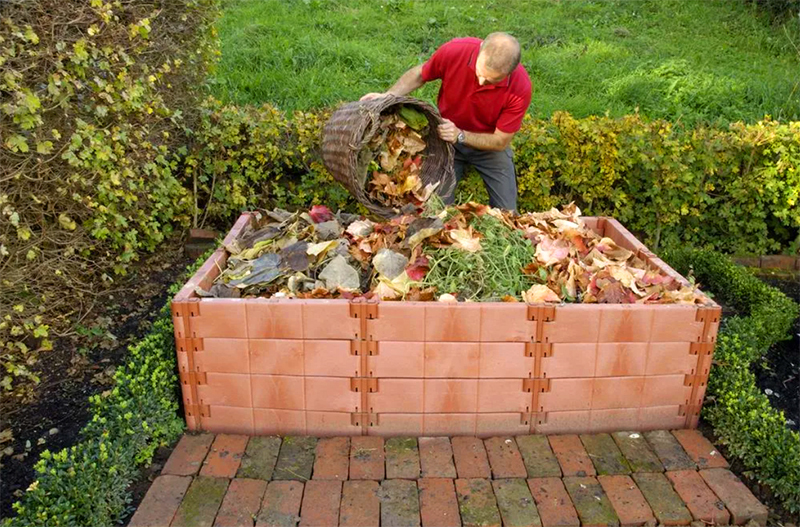
It is undesirable to arrange a hole right in the garden. The reason is that the most unpleasant pests for the gardener (after moles) - bears - will tend to the warm rotting compost for the winter. They lay their larvae in the compost and multiply in it, and then settle from the compost throughout the garden.
Another condition for the successful maturation of compost is its constant moisture, ideally with rainwater. It would be nice if a barn or another outbuilding is located somewhere nearby, and the drains from the roof of this structure can be led into a pit.
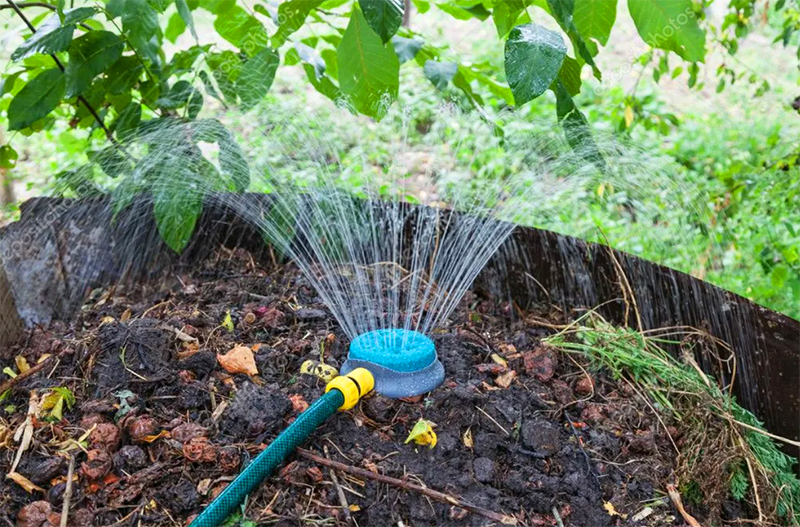
If this is not possible, keep in mind that from time to time the pit will have to be watered. This can be done with a hose or a bucket. From a hose, of course, it is more convenient, so think about where you can connect. Dried compost is not suitable for fertilizer.
It is undesirable to arrange compost too close to or directly under the wall of the building. Active decomposition processes can affect the integrity of a nearby structure, especially if it is wooden. In addition, constant moisture will also have a negative effect.
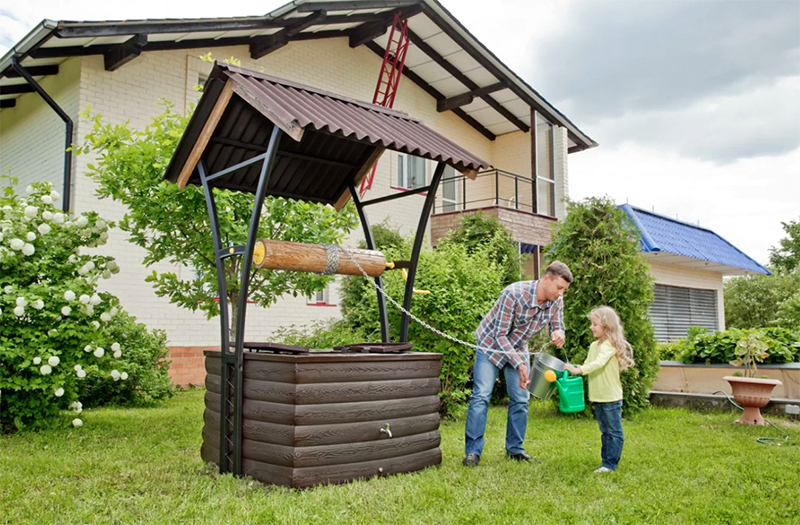
What we get as a result: the compost should not be located directly in the garden, not right next to the house or outbuildings, and not under the noses of the neighbors. Open the drawing of your site and think about where to find such a place.
Big, small, in a pit or a box - which is better?
A compost heap is unlikely to be small, so if you think a 200 liter barrel will be enough for you, then you are wrong. Yes, there are some for sale, but they will be filled in one go, and where will you pawn everything else for the rest of the year? Will you buy a battery of barrels? So the compost needs to be put in a lot at once, and it is better to divide it into three parts to use as it matures.
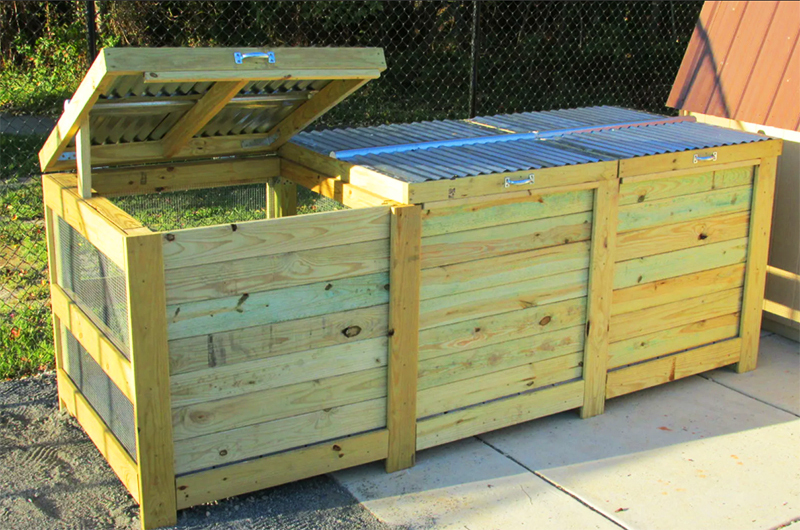
What is more convenient: dig a hole under the compost or make it high, raising it above the ground level? There are some nuances here. If you lay waste in a pit, there will be better conditions for maturation. The temperature will rise faster and the humidity will be better preserved. The compost in the pit rarely dries out, so it will need to be watered much less frequently. But, on the other hand, extracting the contents from the pit is much more difficult. Imagine: you have to bend over with a shovel to throw a whole bunch of fertilizer, lifting it into a wheelbarrow to take it to the beds. Your back will definitely hurt for more than one day. And when you consider that for uniform maturation, the contents of the compost need to be mixed from time to time, the task becomes even more difficult.
It is much easier and more convenient to work with compost that is in a box.

In addition, the location above the ground will allow the compost heap to freeze, and this will not please the bears and other pests.
How to arrange compost on the site
So, a box above the ground is much more convenient than a pit. What else is important for making a compost heap? How to do it right?
Let's start with the problem of "tenants" of compost. Usually earthworms live in it perfectly. They feed on plant residues, and this is very good, because the result of the vital activity of earthworms is humus - a natural fertilizer invaluable to plants. Some summer residents not only welcome the cultivation of worms in compost, but even buy special varietal varieties of low-bristle ones that breed well in food waste.
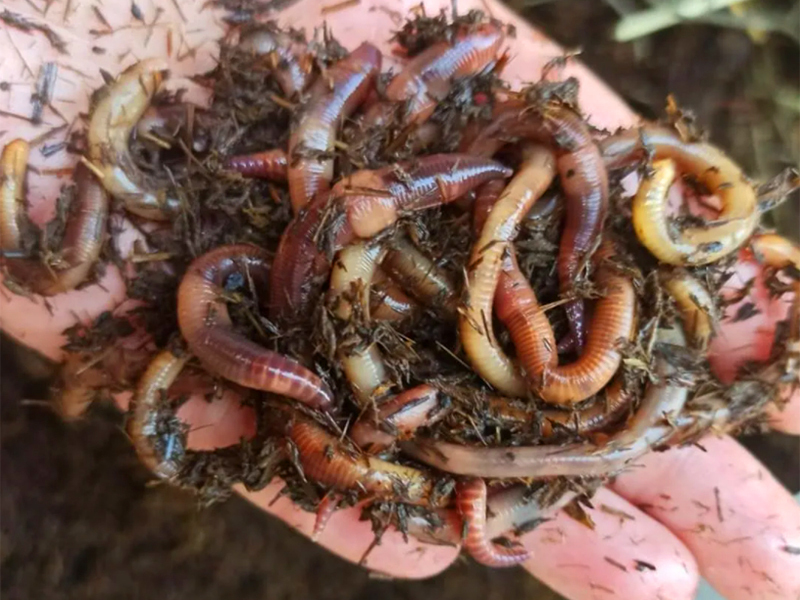
Worms grown in compost are always larger and fatter than those that live in ordinary soil. The problem can only be that due to a lack or excess of moisture, these "residents" can leave your property. So it is important that moisture does not quickly leave the compost: walls are needed that sufficiently retain it inside, but do not turn the compost into a reservoir.
The second problem is the very bears that will tend to a warm heap. Usually these pests dig long and deep passages to get to their habitat. If you exclude access to the contents of the compost through the bottom of the box, most of the problem will be solved. Medvedki can get out to the surface, so you need to protect the lower part of the walls by about 10–15 cm.
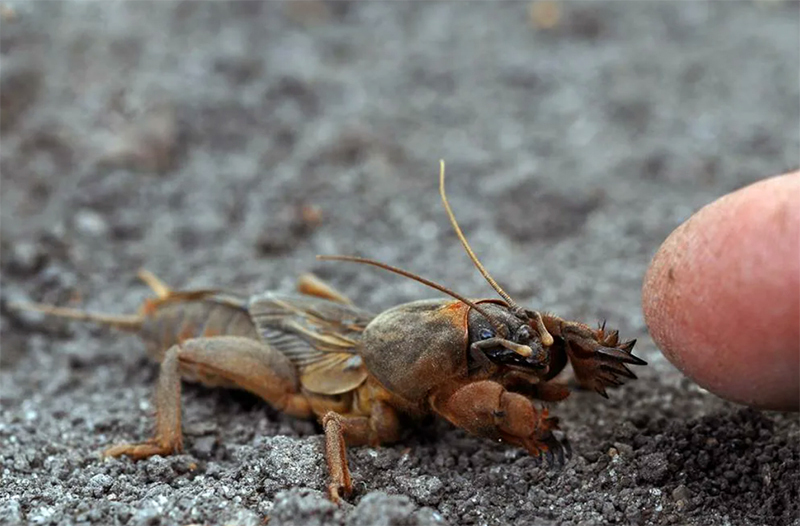
You can even use a fine mesh, which is made to reinforce the plaster. These large insects will not crawl through it to lay their larvae.
In addition to the tenants, there is also the problem of moisture, which we have already touched upon in the discussion of "tenants". That is, the compost bin must protect the heap from drying out, retaining moisture, but passing its excess. Wooden grating or perforations in metal walls are a great way to accomplish this task.
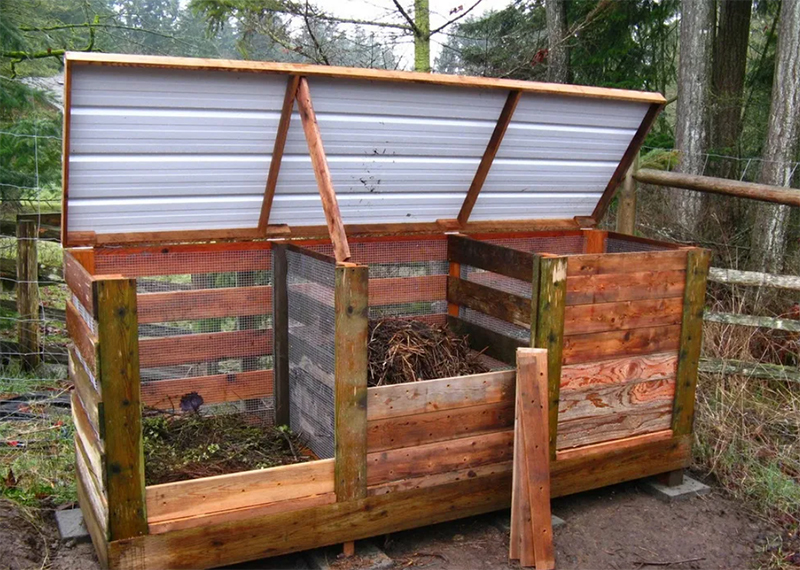
Why you can't put anything in compost
Indeed, there are some prohibitions on laying compost. If they are violated, the resulting fertilizer cannot be used and time will be wasted.
Compost rots and turns into a set of useful substances due to the active work of beneficial bacteria. But comfortable conditions for them are just as comfortable for pathogens. So if you pile up diseased plants, there is a risk that the microorganisms that caused diseases, safely survive the winter and then, together with fertilizer, fall back into the soil on your plot.
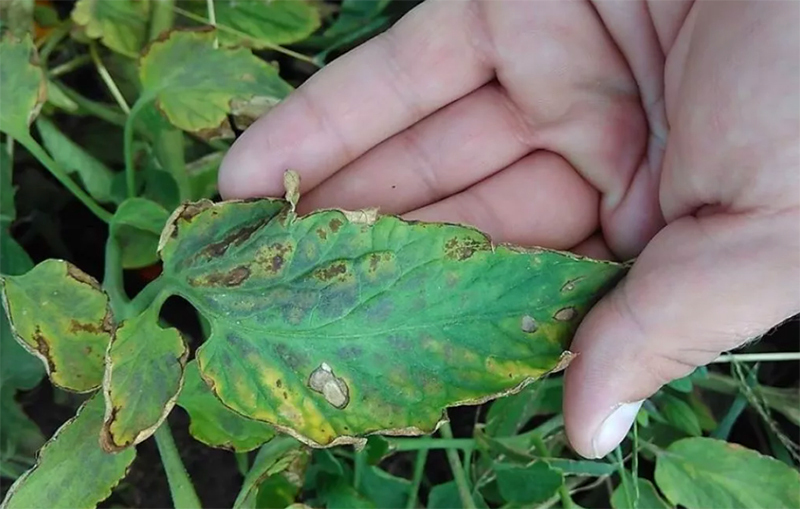
Pay attention to the foliage of fruit trees, which is also laid in the compost. She must be healthy. By the way, the foliage of walnut, hazel and oak is not suitable for laying in its natural form due to the fact that it contains a lot of tannins. It needs to be collected in dry heaps, burned and only ashes should be poured into the compost.
And another type of waste is not suitable for a compost heap - the remains of animal food. It is undesirable to put meat, fish, trimmings of meat and fish products into it. The fact is that food residues of this type, when rotting, emit a pungent odor that your household and neighbors are unlikely to like. By themselves, such waste can also be useful, but not in compost. For example, when planting a young seedling of a fruit tree, it is very good to put oily fish like herring in the root hole - the tree will receive a lot of nutrients.
You should not put inorganic waste in the compost yet: they do not rot and then remain in your fertilizer as garbage.
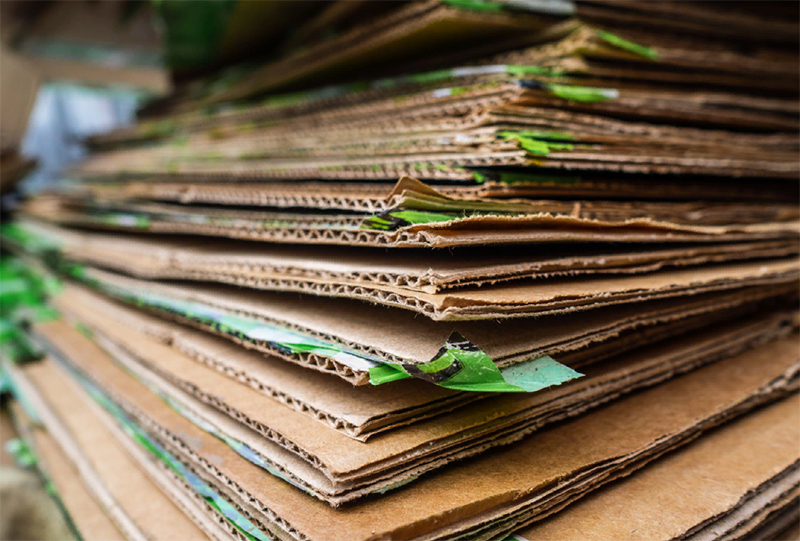
The peel of oranges, lemons and tangerines, wine pomace, lime, nutshells will not bring benefits.
How and from what to make a compost pit with your own hands
It is possible to build a tank for the disposal of food and vegetable waste from different materials. Each of them has its own merits and almost all of them are not difficult for a do-it-yourself device.
Compost from concrete or concrete rings
A capital compost pit can be made of monolithic concrete or concrete rings. This method is more suitable for a structure buried in the ground. Such pits are airtight, and there will be no smell from them, even if feces are placed in them. Concrete prevents the contents from seeping into the ground, creates conditions for retaining moisture and prevents pests from penetrating inside.
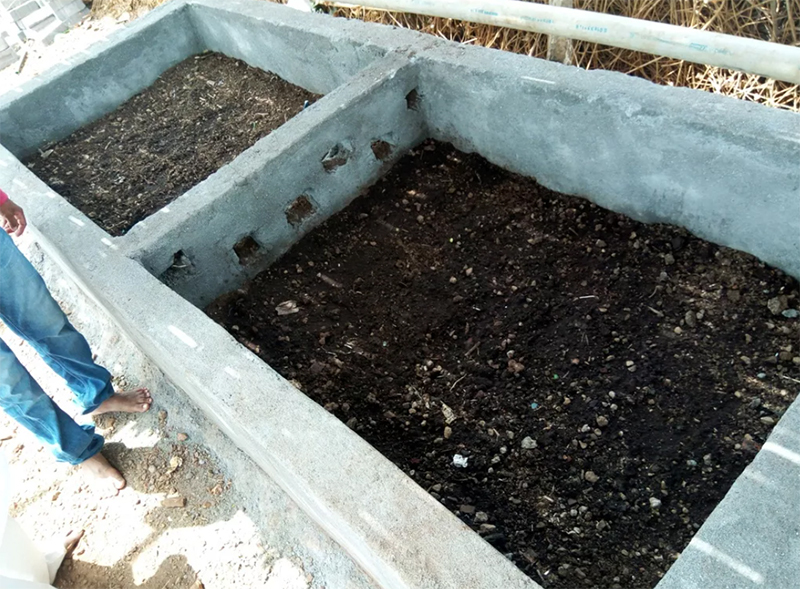
The construction technique is very simple: they dig a hole up to 1.5 meters deep, make a formwork and fill it with concrete. There is not much point in digging deeper - then it will be difficult for you to extract the rotted fertilizer or stir it up.
In the upper part of such compost, a grate and a leaky lid are placed to ensure ventilation.
Making a compost pit out of concrete rings is also easy, but you will need a technician to install heavy rings into the pit.
Compost in concrete pits is laid in layers: feces are shifted by plant residues and sprinkled with ash.
brick composter
If you set yourself the task of making a durable structure and once and for all forget about arranging a composter, then consider brick as a material.
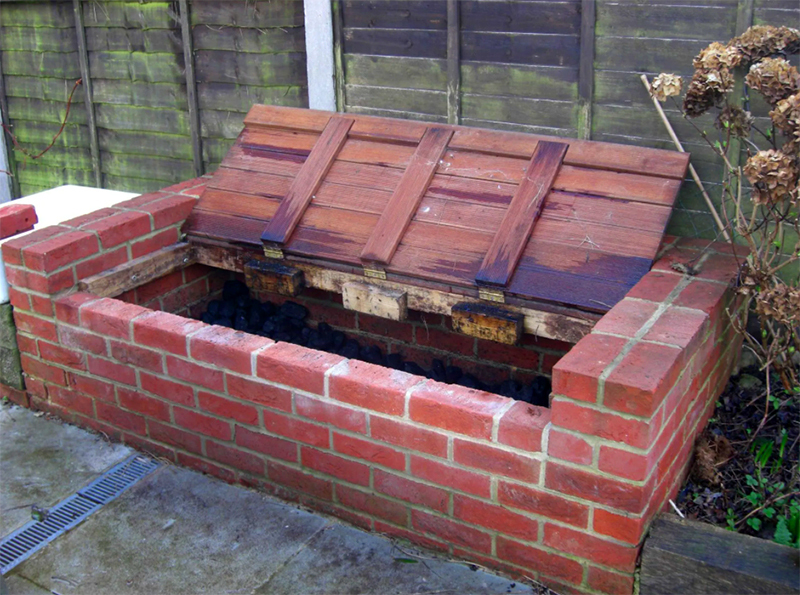
What is important for a brick composter? It can be built on the surface of the ground or deepened, but to a depth of no more than half a meter. A brick composter can be laid out with cement mortar, or it can be dry, without a binder. It makes sense to make one wall collapsible - this way you will greatly simplify the process of caring for fertilizer. You can make 3 walls of bricks, and the front of wooden boards is also a convenient option.
Compost bins made of wood and pallets
The remains of construction wood are excellent material for building compost bins. The main condition is that the boards for the box must be thick and durable. Rotten and cracked will not work: in the process of decay, microorganisms from the compost will actively interact with the wood, and flimsy materials will quickly collapse.
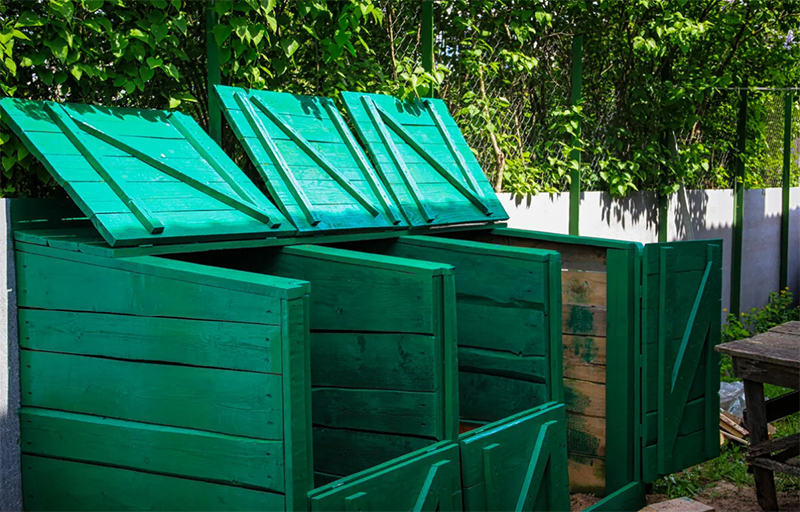
Compost bins from boards are built so that there are small gaps between the boards - this will improve the aeration of the ripening fertilizer and will favorably affect the work of microorganisms. But you need to remember that such boxes need to be regularly spilled with water to prevent drying out.
Wooden pallets, on which bricks are usually brought, are excellent as a material. They have good strong boards, and the dimensions of the pallets are optimal for creating a single-section box. Take 9 of these pallets - and you get a full-fledged three-section design that can be assembled in just an hour.
Compost structures from slate
Sheet or corrugated slate is also suitable for the construction of an above-ground composter. In order for the structure to be durable, it is mounted on a frame made of timber. Slate is not afraid of the rotting process, so such a box, with careful handling, will last a very long time until the frame collapses.
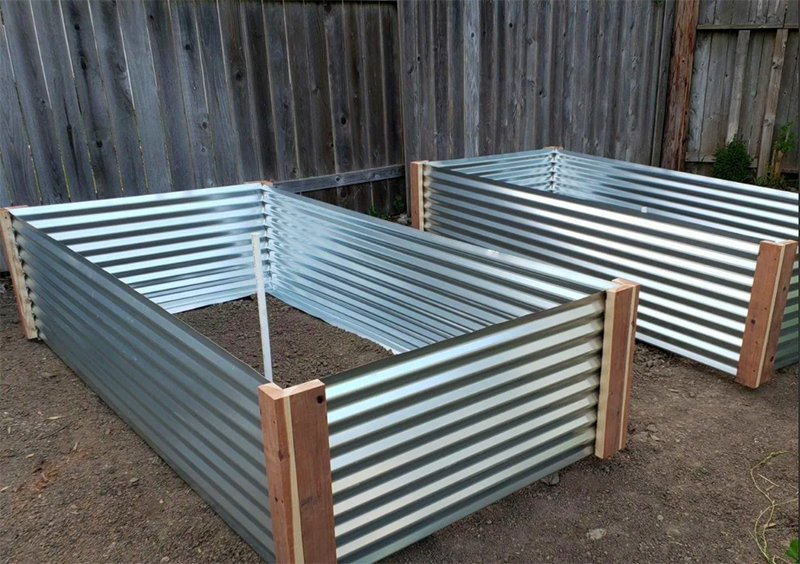
To make it convenient to take care of the compost, the front wall of the slate box is made of wood. You can use the same pallets.
Compost bin
Another simple and cheap material for building a composter is a metal mesh. It is better to take a welded mesh, and not a chain-link, which will deform under the weight of the contents of the compost. The grid is attached to a wooden or metal frame.
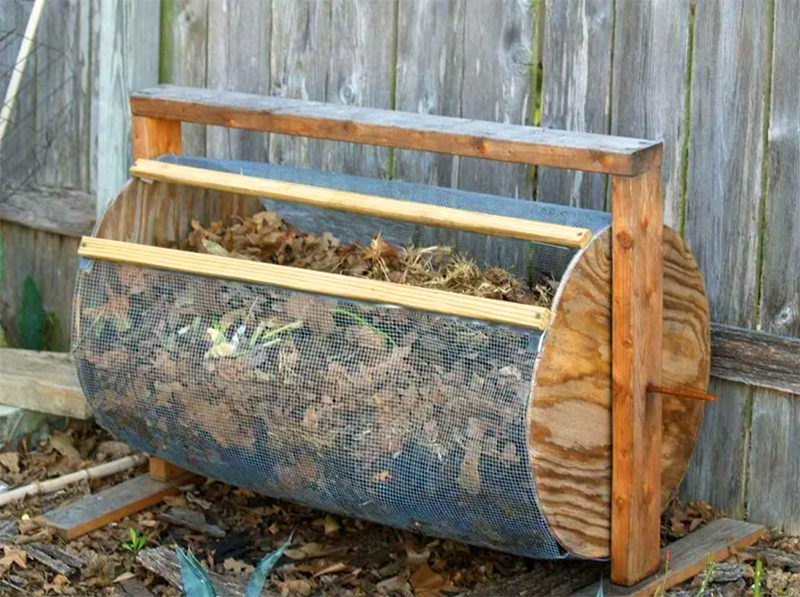
Compost boxes from barrels and tires
If you do not want to make a large compost heap and limit the bookmark to only food waste, then you can get by with small containers. You can build a compost tank from an old metal or plastic barrel. You just need to make perforations in them to remove excess moisture.

How to speed up the maturation of compost
To get high quality fertilizer and as quickly as possible, it is necessary to correctly lay the compost. This is done in layers. Plant residues are interspersed with feces and a layer of soil.
As already mentioned, the quality of compost is significantly improved by earthworms. And the more of them, the better.
On sale there are preparations on a natural basis to accelerate the maturation of humus. "Compostello", "Gumi-Omi", "Baikal-M" - all these compounds accelerate the process of decay by at least 2 times and are absolutely safe. With them, the compost will rot in one season, while without special additives, it will take at least two for the microorganisms to completely process everything.
There are folk methods to speed up the maturation of compost. For example, regular baker's yeast works great. Add 5 tablespoons of dry yeast and a kilogram of sugar to a bucket of water. Brazhka should ferment for a day before it is poured into compost. Instead of yeast, you can use kefir dissolved in water, skim or whey. Pour these mixtures not on top of the compost, but in the recesses in it, so that the liquid gets as deep as possible into the pile.
Finnish compost technology
The features of this technology allow competently laying compost throughout the season. For this, three-section boxes are installed. Waste is placed in the first of them in the spring. Then, a month later, the second box is filled, and when it is full, they proceed to the third. With the use of compost ripening accelerators in the first two boxes, the fertilizer will be ready by the beginning and end of autumn, and it will be possible to apply it for digging. How to make a compost heap for this technology - in a small but detailed video:
What type of compost is best for you? What methods do you use to speed up maturation? Share your experience and opinion in the comments!
and if the top layer of foam is not broken, then the lacquer surface greatly reduces the hygroscopic ...
strange reasoning regarding sealing. If the log is doused with sealant, foam ...
In the 80s he worked in one NPO, then hammer enamel was sintered. It turned out great,...
While in the summer I lived in the country a lot of different situations I saw and no one fines anyone. Uch…
You won't find a normal apartment for such a sum in Moscow. Even for a country house that …
Thank you. Briefly and clearly...
Karting. I want to help children! &nbs …
Now there is a very interesting and effective option for heating - plasterboard pas …
Everything is chic, but the emphasis is always on the ratchet. And for me, for example, it is technologically not p ...
yes indeed. you won’t call them later for the whole year no one appeared, they began to hear ...
And why sheathe the house initially with vapor barrier? What is its meaning? To create a conden…
A little over a month ago, I was looking for an Electrolux heating kit for a loggia. We have a lodge...
In general, I support it, only concrete does not lose its properties after wintering, especially if ...



